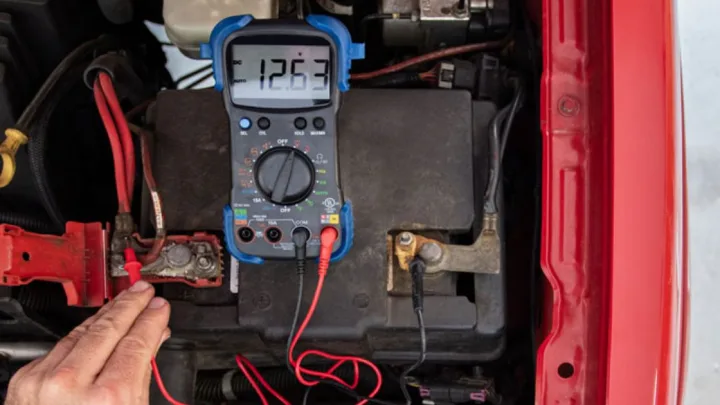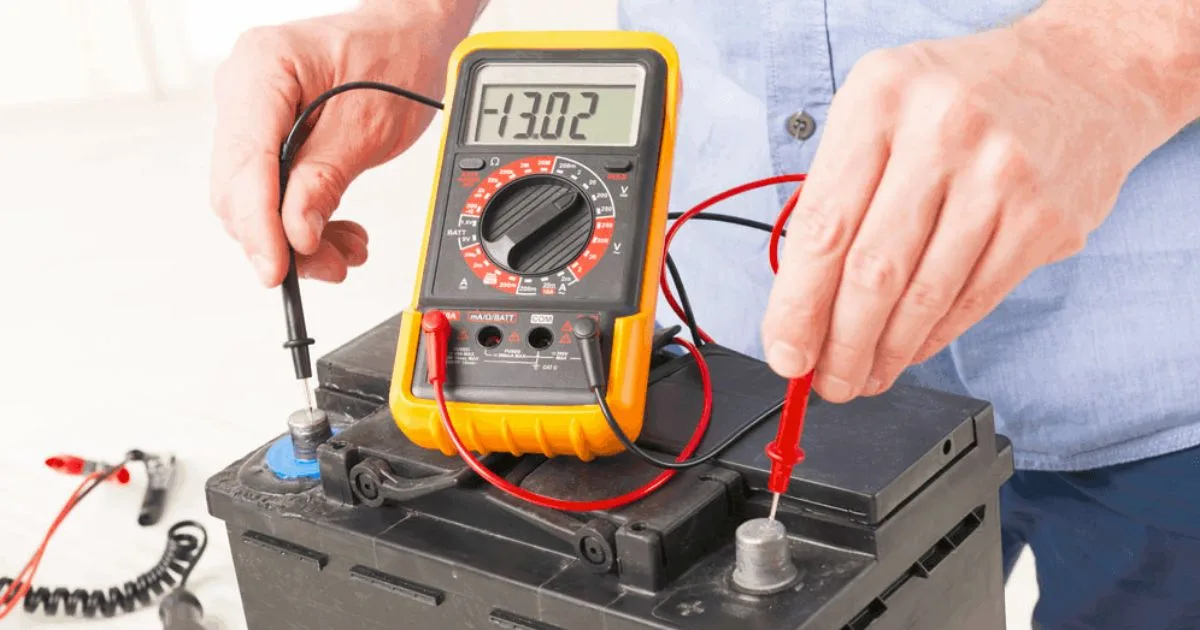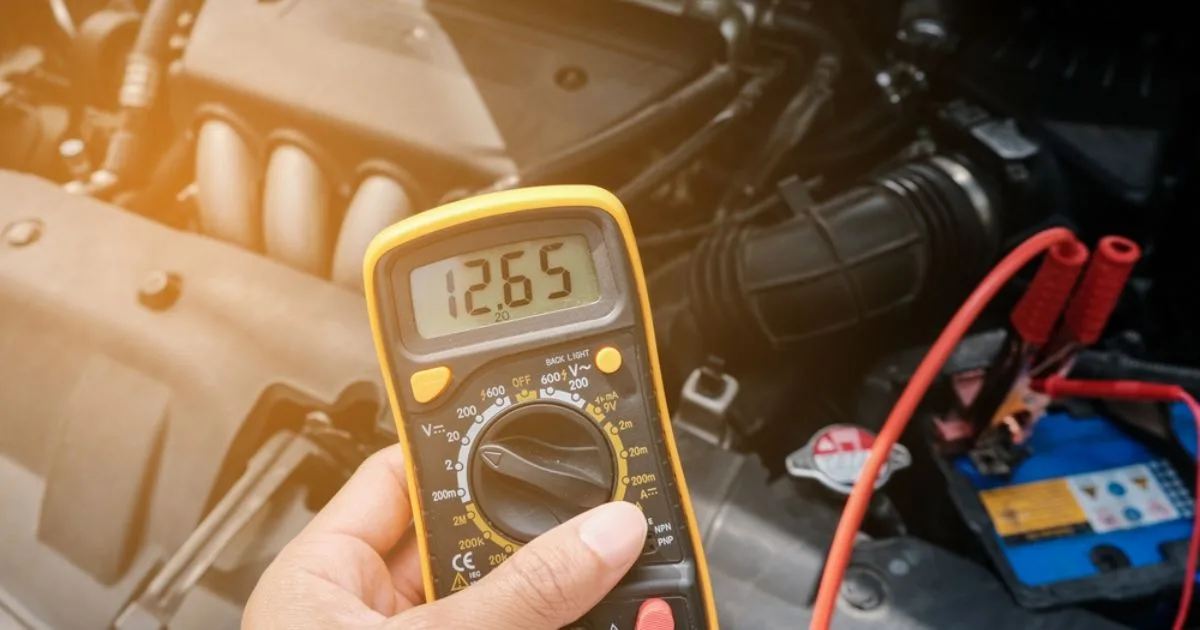
Testing your car battery with a voltmeter is essential. It helps you know if your battery is in good condition.
Understanding how to use a voltmeter can seem tricky at first. But don't worry; it's easier than it looks. With a step-by-step guide, you can check your car battery's health in no time. This blog will walk you through the process, making sure you get accurate readings. Whether you're a car enthusiast or a beginner, these steps are simple to follow. By the end, you'll feel confident in using a voltmeter on your car battery. Let's get started!Introduction To Voltmeter Usage
Using a voltmeter to check your car battery might sound like a task for a seasoned mechanic, but it's actually quite simple. Whether you're a car enthusiast or just want to ensure your vehicle is running smoothly, understanding how to measure your car battery's voltage can save you time and money. Let's dive into the basics of voltmeter usage and why it's so important.Importance Of Measuring Voltage
Why should you measure the voltage of your car battery? Well, it's all about ensuring your car is in good health. A car battery with the right voltage means your vehicle will start without any hiccups. On the other hand, a low voltage could indicate a problem that needs immediate attention. In short, measuring voltage helps you:- Prevent unexpected breakdowns
- Extend your battery's lifespan
- Save money on repairs
Basic Functions Of A Voltmeter
Before we get into the nitty-gritty of using a voltmeter, let's understand its basic functions. A voltmeter is an electronic device that measures the voltage between two points. It usually has:- Two probes – a red one for positive and a black one for negative
- A digital or analog display – to show the voltage reading
- A mode selector – to choose between different measurement types (like AC or DC voltage)
| Component | Function |
|---|---|
| Red Probe | Connects to the positive terminal |
| Black Probe | Connects to the negative terminal |
| Display | Shows the voltage reading |
| Mode Selector | Switch between measurement types |
 Safety Precautions
Safety Precautions
Safety Precautions
Before diving into the nitty-gritty of using a voltmeter on your car battery, it's crucial to understand the safety precautions. These steps ensure you avoid any mishaps or injuries while working with your car battery. Remember, safety first! Let's explore the key safety measures you need to take.Wearing Protective Gear
First things first, always wear protective gear. Why, you ask? Well, car batteries contain acid, which can cause severe burns. Plus, they can emit hydrogen gas, which is highly flammable. Here's what you need:- Safety Goggles: Protect your eyes from any accidental splashes.
- Gloves: A good pair of rubber gloves can shield your hands from acid.
- Long Sleeves: Wear a long-sleeve shirt to protect your arms.
Ensuring Car Is Turned Off
Now that you're all geared up, the next step is to make sure the car is turned off. Working on a live car battery is a big no-no. Why? Because it can lead to electric shocks or even an accidental start of the engine.- Turn Off the Ignition: Ensure the key is out of the ignition.
- Disconnect the Battery: If needed, disconnect the battery to be extra safe.
Types Of Voltmeters
When it comes to checking your car battery, the type of voltmeter you use can make a big difference. Voltmeters come in two main types: Analog and Digital. Each has its own set of pros and cons. Understanding these can help you choose the right tool for the job. Let's dive into the details.Analog Voltmeters
Analog voltmeters are the old-school tools of the trade. They have a needle that moves across a scale to show the voltage. While they might seem a bit retro, they are still quite effective. Here’s why you might want to use one:- Simple to Use: No need to fuss with settings or buttons. Just connect and read.
- Durable: These voltmeters are tough and can handle a bit of rough treatment.
- Quick Read: The needle gives you an immediate visual indication of voltage.
Digital Voltmeters
Digital voltmeters are the modern alternative. They use a digital display to show the exact voltage. Here’s why they are popular:- High Accuracy: Digital voltmeters give precise readings, down to a fraction of a volt.
- Easy to Read: The numbers on the screen are clear and easy to understand.
- Additional Features: Many digital models come with extra functions like auto-ranging and data hold.
Choosing The Right Voltmeter
Choosing the right voltmeter is crucial for accurate readings of your car battery. A voltmeter helps you monitor your battery's health and performance. There are different types of voltmeters available, each with unique features and benefits. Understanding these features can help you make an informed decision.Features To Consider
When selecting a voltmeter, consider its accuracy. Accurate readings are vital for diagnosing battery issues. Look for a voltmeter with a digital display. Digital displays are easier to read and provide precise measurements. Check the voltage range of the voltmeter. Ensure it covers the range needed for your car battery. Another important feature is durability. Choose a voltmeter with a sturdy build to withstand regular use. Portability is another factor. A compact and lightweight voltmeter is easier to carry and store. Look for additional features like auto-ranging and data hold. Auto-ranging adjusts the range automatically for the best accuracy. Data hold allows you to freeze the reading for easy recording. Finally, consider the price. Find a voltmeter that fits your budget while offering essential features.Recommended Brands
Several brands offer reliable voltmeters. Fluke is a well-known brand with high-quality voltmeters. Their products are known for accuracy and durability. Another recommended brand is Klein Tools. They provide user-friendly voltmeters with clear displays. Innova also offers affordable and reliable voltmeters. Their products are suitable for beginners and experienced users alike. Extech is another brand worth considering. They offer a wide range of voltmeters with various features. AstroAI is popular for its budget-friendly options. Their voltmeters are simple to use and provide accurate readings. These brands are trusted by professionals and hobbyists alike.Preparing Your Car Battery
Before you can use a voltmeter on your car battery, it is crucial to prepare the battery. Proper preparation ensures accurate readings and safety. This section will guide you through the essential steps to get your car battery ready, focusing on locating the battery and cleaning the terminals.Locating The Battery
First things first, you need to find your car battery. In most vehicles, the battery is located under the hood. However, in some models, it might be in the trunk or even under the back seat. Check your car’s manual if you’re unsure. Here’s a simple way to locate it:- Pop the hood (or open the trunk).
- Look for a rectangular box with two cables connected to it. One cable is usually red, which is the positive terminal, and the other is black, the negative terminal.
Cleaning The Terminals
Next, you need to clean the battery terminals. Why, you ask? Dirty terminals can mess with your voltmeter readings. Here’s how to clean them:- Gather your supplies: You’ll need a wire brush, baking soda, water, and a cloth.
- Mix your solution: Combine a tablespoon of baking soda with a cup of water. This will help neutralize any battery acid.
- Disconnect the battery: Start with the negative terminal (black), then the positive (red).
- Clean the terminals: Use the wire brush and baking soda solution to scrub away any corrosion or dirt.
- Dry the terminals: Wipe them with a clean cloth to ensure they are dry and free from any residue.
 Connecting The Voltmeter
Connecting The Voltmeter
Connecting The Voltmeter
To check your car battery's voltage, you must connect the voltmeter correctly. This step is crucial to get an accurate reading. Follow these simple steps to connect the voltmeter to your car battery.Attaching The Positive Lead
First, locate the positive terminal on your car battery. The positive terminal usually has a plus (+) sign. It might also be red. Take the red lead from your voltmeter. Attach it to the positive terminal of the battery. Make sure it is secure to get a proper reading.Attaching The Negative Lead
Next, find the negative terminal on your car battery. The negative terminal usually has a minus (-) sign. It might also be black. Grab the black lead from your voltmeter. Connect it to the negative terminal of the battery. Ensure it is firmly attached for an accurate result. Now, your voltmeter is connected to the car battery. You are ready to take a reading.Reading The Voltage
Reading the voltage on your car battery is a simple yet crucial task. It helps ensure your battery is in good condition. By using a voltmeter, you can get accurate readings. This section will guide you through the steps needed to read the voltage properly.Interpreting The Display
Once you connect your voltmeter to the car battery, a number will appear on the display. This number represents the voltage of your battery. A healthy car battery typically shows around 12.6 volts when fully charged. If the reading is below 12.4 volts, your battery may need charging. If it’s below 12 volts, your battery might be failing.Understanding Voltage Ranges
Knowing the voltage ranges helps you understand your battery's health. A reading between 12.4 and 12.6 volts indicates a well-charged battery. If the voltmeter shows less than 12.4 volts, the battery might be undercharged. Below 12 volts often means the battery is weak or near the end of its life. Regular checks can help you avoid battery issues.Troubleshooting Common Issues
Using a voltmeter on your car battery is simple. However, you may face some common issues. This section will guide you on how to handle them. Knowing how to troubleshoot can save you time and effort.Dealing With No Reading
Sometimes, your voltmeter may show no reading. First, ensure the voltmeter is on. Check if the leads are connected properly. Verify if the probes touch the battery terminals. If all seems correct, the battery might be dead. Try using the voltmeter on another battery. If it works, your car battery needs replacement. If not, the voltmeter could be faulty. Consider replacing it.Handling Fluctuating Readings
Fluctuating readings indicate a problem. First, check the connections. Loose or dirty terminals can cause issues. Clean the terminals and try again. Ensure the probes stay in contact with the terminals. If the readings still fluctuate, the battery might be weak. Another possible issue is a faulty alternator. Test the alternator to confirm. Address the specific issue based on your findings.Maintaining Your Voltmeter
Maintaining your voltmeter ensures accurate readings and a longer lifespan. Proper care and regular checks keep your device reliable. This section explains how to store and calibrate your voltmeter for optimal performance.Storing Properly
Store your voltmeter in a dry, cool place. Moisture can damage its components. Keep it away from direct sunlight to avoid overheating. Use a protective case if possible. This prevents dust and dirt from entering. Remove the batteries if you won't use the voltmeter for a while. This avoids battery leaks that can damage internal parts. Always store your voltmeter with care to ensure it stays in good condition.Regular Calibration
Calibrate your voltmeter regularly for accurate readings. Check the manual for calibration instructions. Some models have an auto-calibration feature. Follow the steps provided to ensure the voltmeter functions correctly. Use a known voltage source for calibration. Compare the reading with the known value. Adjust the voltmeter if necessary. Regular calibration ensures your voltmeter remains precise and trustworthy.Conclusion And Tips
So, you’ve learned how to use a voltmeter on your car battery. Great job! With this skill, you can check the health of your car battery and avoid unexpected breakdowns. Now, let's wrap things up with some key points and handy tips to keep your battery in top shape.Regular Battery Checks
Making a habit of checking your car battery regularly is important. Just like you wouldn’t ignore a toothache, don’t ignore your car battery. Here’s a simple routine:- Weekly checks: Especially if you often drive short distances.
- Monthly checks: For regular use under normal conditions.
- Before long trips: Always check to ensure your battery is healthy.
Ensuring Longevity Of Equipment
Want your voltmeter and battery to last longer? Here are a few tips:- Store your voltmeter properly: Keep it in a dry, cool place. Avoid dropping it or exposing it to extreme temperatures.
- Keep connections clean: Dirt and corrosion can affect readings. Clean the battery terminals and voltmeter probes regularly.
- Use the right settings: Always set your voltmeter to the correct voltage range before testing. This avoids damage to the device.
Conclusion
Using a voltmeter on your car battery is simple. Just follow the steps. First, gather your tools. Next, set your voltmeter. Then, check your battery terminals. Read the voltage displayed. This helps diagnose battery issues. Regular checks ensure your car runs smoothly. It's a quick way to keep your vehicle in good shape. Now you're ready to use a voltmeter confidently. Keep your car battery healthy and avoid unexpected breakdowns. Happy driving!Disclosure
Some links may be affiliate links. That means we may earn a small commission at no extra cost to you.